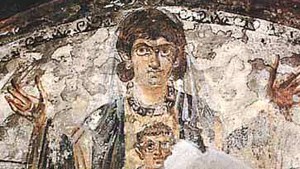During the Advent season churches everywhere ring out with the hymn “O Come, O Come Emmanuel.” It is a favorite of many and is one of the most requested hymns during the month of December.
The hymn is also one of the oldest Advent traditions, deeply tied to the liturgy leading up to the celebration of Christmas.
The origins of the hymn is hard to decipher. Throughout history the verses of the hymn were known as the “O Antiphons” or “Great Antiphons.” Father William Saunders explains, “Boethius (c. 480-524) made a slight reference to them, thereby suggesting their presence at that time … By the eighth century, they are in use in the liturgical celebrations in Rome.” Some believe that the O Antiphons can even be traced back to the very early Church.
Traditionally these verses are sung during the Liturgy of the Hours (also known as the Divine Office), and precede the recitation of the “Magnificat” (see Luke 1:46-55). Dom Guéranger explains in his Liturgical Yearthe symbolism of singing these verses during Evening Prayer (Vespers).

Read more:
A beginner’s guide to the Liturgy of the Hours
The canonical Hour of Vespers has been selected as the most appropriate time for this solemn supplication to our Savior, because, as the Church sings in one of her hymns, it was in the Evening of the world (vergente mundi vespere) that the Messias came amongst us. These Antiphons are sung at the Magnificat, to show us that the Savior, whom we expect, is to come to us by Mary.
Each antiphon (or each verse of the hymn) is recited/sung on successive days leading up to Christmas, starting on December 17 and ending on December 23. The antiphons are biblically based and feature a different title of the Messiah from the Old Testament.
In various monasteries they added additional antiphons, such as one to “our Blessed Lady, O Virgo Virginum; and the other to the Angel Gabriel, O Gabriel; or to St. Thomas the Apostle, whose feast comes during the Greater Ferias; it began O Thoma Didyme.”
The antiphons are a beautiful way to prepare for Christmas and have always had a special place in the hearts of Christians. Below are the traditional O Antiphons and the corresponding day that they are sung. (If you are interested in the original Latin, check them out here.)
December 17
O Wisdom of our God Most High,
guiding creation with power and love:
come to teach us the path of knowledge!December 18
O Leader of the House of Israel,
giver of the Law to Moses on Sinai:
come to rescue us with your mighty power!December 19
O Root of Jesse’s stem,
sign of God’s love for all his people:
come to save us without delay!December 20
O Key of David,
opening the gates of God’s eternal Kingdom:
come and free the prisoners of darkness!December 21
O Radiant Dawn,
splendor of eternal light, sun of justice:
come and shine on those who dwell in darkness and in the
shadow of death.December 22
O King of all nations and keystone of the Church:
come and save man, whom you formed from the dust!December 23
O Emmanuel, our King and Giver of Law:
come to save us, Lord our God!

Read more:
In what posture did the early Christians pray?

